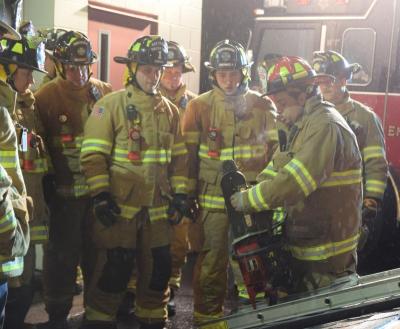Firefighters test their skills and gear at training session
Practice makes perfect, especially when it comes to delicate firefighting procedures designed to save lives. That’s why on November 20, Fire District No. 1 crews gathered at the fire station to practice an important firefighting technique: Roof venting.
When firefighters first arrive at the scene of a burning building, intense heat and smoke have already been building. Firefighters may need to cut careful, precise holes in the roof to provide an avenue for its escape.
It’s a delicate procedure which requires specialized hardware, which means plenty of hands-on training is necessary before firefighters have to face it during a real emergency.
Using a specially built mock roof built out of wood behind the fire station, recent fire academy graduates took turns testing out what they have learned in the classroom when it comes to roof cuts.
Crews practiced each step of the process. It includes “sounding” the roof — testing it to make sure it is safe to support the crew’s weight, and determining what the roof made of — cutting specifically sized holes in the roof, and peeling back the roof structure once the holes are cut.
It can be a significant challenge based on the design and material of the roof, explained Acting Chief Jake Bettencourt. Some homes within District 1’s South Dartmouth coverage area feature extreme pitched roofs, making climbing them a risky challenge. The training session allowed crews to get used to using their equipment in a safe environment, to help better prepare them for those challenges.
“This is an excellent training opportunity,” Bettencourt said. “They’re getting used to the equipment.”
During a classroom session before crews tried out the exercise, instructor Lt. Jeff Costa noted everything from the age of the wood, to the material matters.
Even flat roofs common on commercial buildings can present unique challenges — most are lined with oil-coated pebbles, meaning firefighters need to remember adding a shovel to their tool belts
















